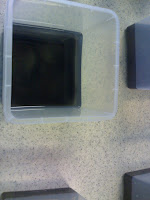Hi,
Week 6 of SIP. I will share my SIP experience chronologically. I am still at histopathology department.
Week 2There was a talk on how to handle spillage. It was briefed to all staff. Training staff on how to handle chemical spills is important because some chemicals are potentially harzardous or flammable. The key point to remember from the talk is MSDS. Material Safety Data Sheet. It contains all the necessary information regarding the chemical.
Next there was a briefing during emergencies, particularly an outbreak of fire. We were taught on fire safety procedures and evacuation route. After these 2 briefings, there was a small quiz for all staff, which was required by JCI. I scored 12/14.
Week 2 was about the same as the first week. I heated slides to melt the wax, labelled casettes and sorted slides. We also had a rough idea on our major project. To find out the minimum processing time.
Week 3I labelled chemical bottles in the cabinet. We have to check the expirary date, date of opening and batch number. I was assigned to do this because there is a JCI inspection next week. We have to ensure all chemicals and materials are accounted for and not expired.
Apart from checking chemicals, I did slide sorting for the whole week. A recap: we have to sort according the the biopsy number eg. 08-12345, then followed by the block number eg. A3, then by the number of levels being cut. eg. VL 2.
For example, this is how we arrange it.
(A1 vl 1/3 08-19000)
(A1 vl 2/3 08-19000)
(A1 vl 3/3 08-19000)
(A2 08-19000)
(B1 08-19000)
(A1 08-19001)
(A2 vl 1/2 08-19001)
(A2 vl 2/2 08-19001)
(A1 08-19005)
Notice that some blocks do not have "vl" because the block is only cut once. Meaning only one layer is cut. vl stands for variable level. The 08 in the biopsy number 08-xxxxx, stands for the year, 2008.
Apart from sorting, I rearranged boxes of blocks in the store room. We have to keep blocks for at least 5 years. Just in case the doctors requires a re-examination when a patient suffers a relapse or the doctor made a mistake 5 years ago.
Week 4JCI inspection week. We didn't do much work this week because the auditors from JCI may come any day. JCI inspection occurs once every 2 years. I heard from one of the staff that there are 3 standards in JCI acceditation, a basic level, silver and gold. Currently, my lab is at the silver standard. After this inspection, it may become gold.
We also managed to collect some tissues this week for our project. But unfortunately for JCI, we weren't able to use it. Furthermore, our machine temporarily malfunctioned on friday.
Week 5Besides heating and sorting slides, I have started shaving blocks. There are about 500-700 blocks in a day and it is rather tiring to shave all of them. It is fun because I can finally get to use the microtome. Oh and I accidentally cut my finger, fortunately only the skin peeled off, no bleeding. The blade is very very sharp.
Shaving is done at 20 um instead of the usual 4 um that we use for sectioning.
I was on MC one of the days. Apparently, there is a flu bug going around the lab where more than 5 staff have gotten sick, including ying chee. And on Friday, we went back to school for campus discussion. So this week I wasn't around much.
Week 6Shaving of blocks, fishing, sorting slides, heating. We have started processing our tissues that we collected for our project. it was rather sucessful. One of the staff briefly verified our slides and commented that it was acceptable. We have successfully shortened the time!
I have growned to like shaving very much. Eventhough it requires speed and muscle, my job is very important and we have to be alert, so as not to cut too much or too little.
I have also observed how embedding is performed. It is quite easy for standard tissues but for postate and equally tiny tissues, it is rather difficult. Imagine a short hair. We have to use a forcep to carefully pick it up and put it in molten wax. In addition, we have to press it down using a screw-driver like instument. The trouble is, every time after we press it down, we have to remove the instrument, and the tissue always move away.
Thank you
Ernest
TG01
02/08/08









